A Financial Evaluation of a Multiple Inclination, Rooftop-Mounted, Photovoltaic System Where Structured Tariffs Apply: A Case Study of a South African Shopping Centre
Abstract
:1. Introduction
2. Literature Review
2.1. Existing Literature Relating to PV Economic Performance
2.2. History of Tariffs and Solar Pricing in South Africa
2.3. Financial Criteria for PV Systems
- Net present value (NPV);
- Internal rate of return (IRR);
- Levelised cost of energy (LCOE);
- Benefit/cost (B/C) ratio; and
- Payback period.
2.3.1. Costs over the Life Cycle of the PV System
2.3.2. Revenues from the PV System
- = Power generating revenues in an annual period
- = Annual generation
- = Feed-in tariff
- = Self-use electricity price
- = Subsidy price
- = ratio of self-use electricity
2.3.3. Net Present Value (NPV)
- = Net present value of the total investment cost
- = Initial cash flow
- = Cash inflow that will take place after n period
- = Interest rate
- = Number of periods (year)
- = Present value of revenues throughout the lifecycle of the system
- = The NPV of the net income after a given period
- = The NPV of the gross income after a given period
- = The NPV of the total investment cost after a given period
2.3.4. Internal Rate of Return (IRR)
- > 0
- < 0
2.3.5. Levelised Cost of Energy (LCOE)
2.3.6. Benefit/Cost (B/C) Ratio
- If B/C ≥ 1.0 then the project is acceptable based on economic value; and
- If B/C < 1.0 then the project is not economically viable.
2.3.7. Payback Period
2.4. Existing Electricity Tariffs in South Africa
- The notified maximum demand (NMD) load—maximum possible demand of the consumer;
- The time of the day;
- The season of the year;
- The incomer voltage (LV, MV or HV);
- The ability of the user to shift its load;
- The ability of the user to generate electricity; and
- The distance from the distribution point to the load connection point.
- 1$ = R14.77
- 1€ = R18.03
2.5. Defining the Integral to Generate the Mathematical Process
- > 0
- > 0
- = Weekday return on investment (monetary value–rand)
- = Average daily ROI for a month falling in high demand season (monetary value–rand);
- = Number of weekdays in a particular month;
- = Number of Saturdays in the month;
- = Number of Sundays in the month; and
- = Total number of days in the month.
- = Average daily ROI for a month falling in low demand season (monetary value–rand).
3. Experimental Method
3.1. Design Characteristics of the Case Study
- 2889 × 320 Wp PV modules were used in the case study and the system consisted of various strings and arrays to equate to a rated value of 924.48 kWp. The system consisted of a curvature roof to which the PV modules were affixed in various 17- or 18-module strings. In order to prevent current mismatch, the PV modules were connected such that each string’s modules were at the same angle of inclination.
- A combiner box was used to combine the various strings to form a PV array. Similar to the above, the various strings in each array were connected such that the angle of inclination corresponded. This means that each maximum power point tracker (MPPT) consisted of modules affixed at the same angle of inclination.
- ○
- In addition, the combiner box also encompassed the relevant fuses for each string and the lightning protectors.
- 18 × 49.9 KVA grid-tie inverters were utilised in the system such that the maximum potential fed into the microgrid was 898.2 kVA.
- The distribution board was used to combine the feed from the various inverters. Various circuit breakers and surge arrestors were included in the distribution board. The monitoring components (on which the data from the research was based) were also located inside the distribution board.
- The combined electricity was fed into the microgrid of the consumer at the tie-in point, encompassing the main breaker and the power meter.
3.2. Equations Used for Interpretation
- = Average daily ROI for month x in 1st year
- = Average daily ROI for month x in 2nd year
- = Average daily specific ROI (R/kWp/day)
- = Average daily ROI (the monetary currency of SA–rand)
- = Rated DC power of respective MPPT (W)
3.3. Methodology Implemented for Interpretation
- The results were captured using the logging components connected to the various inverters. The logging software provides various information, including the electricity yield as a function of time for a specific MPPT.
- The average daily electricity yield for each MPPT (consisting of a unique angle of inclination) in a particular month was calculated. Once the average daily electricity yield had been calculated, a similar load profile to Figure 3 is generated. By calculating the average daily electricity yield, variabilities (commonly found due to clouding) are removed.
- Calculate the ROI of the PV system as a function of the angle of inclination. The ROI can be calculated using the appropriate integral or through programming that utilises information such as electricity generation at a specific time.
- Once the average daily ROI for a specific month had been calculated, Equation (27) is used to calculate the average ROI for a specific month over the 2 years.
- The results from step 4 are then used to calculate the specific ROI using Equation (28).
4. Results and Discussion
- The information is reliant on data obtained from a case study connected to a certain tariff structure. If a similar analysis is required on a different case study, then the equations must be adapted in line with the concerning tariff structure.
- Since the method is reliant on a trendline, small power production variations (relating to clouding) may not be captured accurately.
- In comparing this methodology to traditional methodologies, increased computing time can be expected when mathematical first principles are used.
5. Conclusions
Author Contributions
Funding
Institutional Review Board Statement
Informed Consent Statement
Data Availability Statement
Conflicts of Interest
Nomenclature
Abbreviations
References
- Bhattacharyya, S.C.; Timilsina, G.R. A review of energy system models. Int. J. Energy Sect. Manag. 2010, 4, 494–518. [Google Scholar] [CrossRef]
- Rehman, S.U.; El-Amin, I. Study of a Solar Pv/Wind/Diesel Hybrid Power System for a Remotely Located Population near Arar, Saudi Arabia. Energy Explor. Exploit. 2015, 33, 591–620. [Google Scholar] [CrossRef]
- Van Vuuren, D.J.; Marnewick, A.; Pretorius, J.H.C. A Theoretical Pre-Assessment of Solar Photovoltaic Electrical Production for Commercial Retail Centers. In Proceedings of the 18th IEEE EEEIC International Conference on Environment and Electrical Engineering, Palermo, Italy, 12–15 June 2018. [Google Scholar] [CrossRef]
- Mahmud, N.; Zahedi, A.; Rahman, S. An event-triggered distributed coordinated voltage control strategy for large grid-tied PV system with battery energy storage. In Proceedings of the 2017 Australasian Universities Power Engineering Conference, AUPEC, Melbourne, Australia, 19–22 November 2017; pp. 1–6. [Google Scholar] [CrossRef]
- Van Vuuren, D.J.; Marnewick, A.; Pretorius, J.H.C. A proposed simulation-based theoretical preconstruction process: The case of solar photovoltaic technology in South African shopping centres. Renew. Sustain. Energy Rev. 2019, 113, 113. [Google Scholar] [CrossRef]
- Mhundwa, R.; Simon, M.; Yongoua, J.N. The electrical energy impact of small-scale onsite generation: A case study of a 75 kWp grid-tied PV system. J. Energy South. Afr. 2020, 31, 1–15. [Google Scholar] [CrossRef]
- Pandarum, A.; Lekoloane, G.; Milazi, D. Trends and Statistics of Solar PV Distributed Generation in South Africa. SA Energy Storage 2018, 2018, 1–7. [Google Scholar]
- Eskom (Pty) Ltd. Strategic Pricing Direction for Standard Tariffs. 2007. Available online: http://www.eskom.co.za/CustomerCare/TariffsAndCharges/Documents/Stratpricidir2.pdf (accessed on 20 August 2018).
- Serameng, T.J.; Van Dyk, E.E.; Roro, K.T. Validation of PVSyst for different photovoltaic module technologies and system design configurations of PV systems operating in central part of South Africa. In Proceedings of the 4th Southern African Solar Energy Conference (SASEC), Stellenbosch, South Africa, 31 October–2 November 2016; pp. 1–6. [Google Scholar]
- Dondariya, C.; Porwal, D.; Awasthi, A.; Shukla, A.K.; Sudhakar, K.; Manohar, S.R.M.; Bhimte, A. Performance simulation of grid-connected rooftop solar PV system for small households: A case study of Ujjain, India. Energy Rep. 2018, 4, 546–553. [Google Scholar] [CrossRef]
- Wittmer, B.; Mermoud, A.; Schott, T. Analysis of PV grid installations performance, comparing measured data to simulation results to identify problems in operation and monitoring. In Proceedings of the 30th European Photovoltaic Solar Energy Conference and Exhibition, Hamburg, Germany, 14–18 September 2015; pp. 2265–2270. [Google Scholar]
- Masini, A.; Menichetti, E. The impact of behavioural factors in the renewable energy investment decision making process: Conceptual framework and empirical findings. Energy Policy 2012, 40, 28–38. [Google Scholar] [CrossRef]
- Walwyn, D.R.; Brent, A.C. Renewable energy gathers steam in South Africa. Renew. Sustain. Energy Rev. 2015, 41, 390–401. [Google Scholar] [CrossRef] [Green Version]
- Swanson, R.M. A vision for crystalline silicon photovoltaics. Prog. Photovolt. Res. Appl. 2006, 14, 443–453. [Google Scholar] [CrossRef]
- Arafa, M.I.A.; Said, E.-S.S.A. A different visions for uninterruptible load using hybrid solar-grid energy. Int. J. Power Electron. Drive Syst. (IJPEDS) 2019, 10, 381–387. [Google Scholar] [CrossRef]
- Dobrotkova, Z.; Surana, K.; Audinet, P. The price of solar energy: Comparing competitive auctions for utility-scale solar PV in developing countries. Energy Policy 2018, 118, 133–148. [Google Scholar] [CrossRef]
- Crago, C.L.; Chernyakhovskiy, I. Are policy incentives for solar power effective? Evidence from residential installations in the Northeast. J. Environ. Econ. Manag. 2017, 81, 132–151. [Google Scholar] [CrossRef]
- do Nascimento, Á.D.J.; Rüther, R. Evaluating distributed photovoltaic (PV) generation to foster the adoption of energy storage systems (ESS) in time-of-use frameworks. Sol. Energy 2020, 208, 917–929. [Google Scholar] [CrossRef]
- Alghamdi, A.S. Potential for Rooftop-Mounted PV Power Generation to Meet Domestic Electrical Demand in Saudi Arabia: Case Study of a Villa in Jeddah. Energies 2019, 12, 4411. [Google Scholar] [CrossRef] [Green Version]
- Bobo, A.; Pretorius, J.H.C.; Enslin, J.H.R. Effect on energy supply contribution by incorporating rooftop photovoltaic systems within the City of Johannesburg. In Proceedings of the IEEE AFRICON: Science, Technology and Innovation for Africa, AFRICON 2017, Cape Town, South Africa, 18–20 September 2017; pp. 1032–1037. [Google Scholar] [CrossRef]
- Sepúlveda-Mora, S.B.; Hegedus, S. Making the case for time-of-use electric rates to boost the value of battery storage in commercial buildings with grid connected PV systems. Energy 2021, 218, 119447. [Google Scholar] [CrossRef]
- Zhou, L.; Zhang, Y.; Lin, X.; Li, C.; Cai, Z.; Yang, P. Optimal Sizing of PV and BESS for a Smart Household Considering Different Price Mechanisms. IEEE Access 2018, 6, 41050–41059. [Google Scholar] [CrossRef]
- Darghouth, N.R.; Barbose, G.; Zuboy, J.; Gagnon, P.J.; Mills, A.D.; Bird, L. Demand charge savings from solar PV and energy storage. Energy Policy 2020, 146, 111766. [Google Scholar] [CrossRef]
- Zhang, S.; Tang, Y. Optimal schedule of grid-connected residential PV generation systems with battery storages under time-of-use and step tariffs. J. Energy Storage 2019, 23, 175–182. [Google Scholar] [CrossRef]
- Chudy, M.; Mwaura, J.; Walwyn, D.; Lalk, J. The effect of increased photovoltaic energy generation on electricity price and capacity in South Africa. In Proceedings of the IEEE AFRICON Conference, Addis Ababa, Ethiopia, 14–17 September 2015. [Google Scholar] [CrossRef]
- Hohne, P.; Kusakana, K.; Numbi, B. Model validation and economic dispatch of a dual axis pv tracking system connected to energy storage with grid connection: A case of a healthcare institution in South Africa. J. Energy Storage 2020, 32, 101986. [Google Scholar] [CrossRef]
- Le Roux, W.G. Optimum tilt and azimuth angles for fixed solar collectors in South Africa using measured data. Renew. Energy 2016, 96, 603–612. [Google Scholar] [CrossRef] [Green Version]
- Xin-Gang, Z.; Yi-Min, X. The economic performance of industrial and commercial rooftop photovoltaic in China. Energy 2019, 187, 115961. [Google Scholar] [CrossRef]
- Talavera, D.; Muñoz-Rodriguez, F.; Jimenez-Castillo, G.; Rus-Casas, C. A new approach to sizing the photovoltaic generator in self-consumption systems based on cost–competitiveness, maximizing direct self-consumption. Renew. Energy 2019, 130, 1021–1035. [Google Scholar] [CrossRef]
- Ling-Zhi, R.; Xin-Gang, Z.; Yu-Zhuo, Z.; Yan-Bin, L. The economic performance of concentrated solar power industry in China. J. Clean. Prod. 2018, 205, 799–813. [Google Scholar] [CrossRef]
- Korsavi, S.S.; Zomorodian, Z.S.; Tahsildoost, M. Energy and economic performance of rooftop PV panels in the hot and dry climate of Iran. J. Clean. Prod. 2018, 174, 1204–1214. [Google Scholar] [CrossRef]
- Bianchini, A.; Gambuti, M.; Pellegrini, M.; Saccani, C. Performance analysis and economic assessment of different photovoltaic technologies based on experimental measurements. Renew. Energy 2016, 85, 1–11. [Google Scholar] [CrossRef]
- WWF. Renewable Energy: Facts and Futures. The Energy Future We Want. 2017. Available online: http://dtnac4dfluyw8.cloudfront.net/downloads/WWF_Energy_Facts_and_Futures_Final_Version.pdf (accessed on 15 February 2018).
- Deloitte Ltd. An Overview of Electricity Consumption and Pricing in South Africa: An Analysis of the Historical Trends and Policies, Key Issues and Outlook in 2017; Deloitte Ltd.: Johannesburg, South Africa, 2017; pp. 1–86. [Google Scholar]
- du Plooy, N.; Brent, A.C.; de Kock, I.; Musango, J. Fostering Sustainable Energy Transitions in South Africa: A System Dynamics Approach to Achieving a Sustainable Electricity Sector; University of Stellenbosch: Stellenbosch, South Africa, 2017. [Google Scholar]
- Pretorius, I.P.; Piketh, S.; Burger, R.; Neomagus, H. A perspective on South African coal fired power station emissions. J. Energy S. Afr. 2015, 26, 27–40. [Google Scholar] [CrossRef]
- Sklar-Chik, M.D.; Brent, A.C. System Cost of Energy Generation Scenarios for South Africa: Understanding the Real Cost of Integrating Energy Generation Technologies; University of Stellenbosch: Stellenbosch, South Africa, 2017. [Google Scholar]
- Eskom Ltd. Tariff History. 2019. Available online: http://www.eskom.co.za/CustomerCare/TariffsAndCharges/Pages/Tariff_History.aspx (accessed on 12 September 2019).
- Plecher, H. South Africa: Inflation Rate from 1984 to 2024 (Compared to the Previous Year), Statista. 2019. Available online: https://www.statista.com/statistics/370515/inflation-rate-in-south-africa/ (accessed on 12 September 2019).
- Montmasson-Clair, G.; Kritzinger, K.; Scholtz, L.; Gulati, M. New Roles for South African Municipalities in Renewable Energy—A Review of Business Models; South African-German Energy Partnership: Pretoria, South Africa, 2017; pp. 1–56. [Google Scholar]
- Dağtekin, M.; Kaya, D.; Öztürk, H.H.; Kiliç, F.Ç. A Study of Techno-Economic Feasibility Analysis of Solar Photovoltaic (PV) Power Generation in the Province of Adana in Turkey. Energy Explor. Exploit. 2014, 32, 719–735. [Google Scholar] [CrossRef] [Green Version]
- Lipp, J. Policy considerations for a sprouting UK green electricity market. Renew. Energy 2001, 24, 31–44. [Google Scholar] [CrossRef]
- Qiankun, W. A Comprehensive Solution for Development of Large Scale Grid-Connected PV Generation in China. Energy Environ. 2015, 26, 83–94. [Google Scholar] [CrossRef]
- Balta-Ozkan, N.; Yildirim, J.; Connor, P.M. Regional distribution of photovoltaic deployment in the UK and its determinants: A spatial econometric approach. Energy Econ. 2015, 51, 417–429. [Google Scholar] [CrossRef] [Green Version]
- Sener, C.; Fthenakis, V. Energy policy and financing options to achieve solar energy grid penetration targets: Accounting for external costs. Renew. Sustain. Energy Rev. 2014, 32, 854–868. [Google Scholar] [CrossRef]
- Jung, J.; Tyner, W.E. Economic and policy analysis for solar PV systems in Indiana. Energy Policy 2014, 74, 123–133. [Google Scholar] [CrossRef] [Green Version]
- Solareff (Pty) Ltd. Embedded Solar PV Generation in South Africa. 2016. Available online: http://www.solareff.co.za/assets/Uploads/Solareff-Info-Brochure-Regulatory-Position-July-2016.pdf (accessed on 20 March 2019).
- Ling-Zhi, R.; Xin-Gang, Z.; Xin-Xuan, Y.; Yu-Zhuo, Z.; Ren, L.-Z.; Zhao, X.-G.; Yu, X.-X.; Zhang, Y.-Z. Cost-benefit evolution for concentrated solar power in China. J. Clean. Prod. 2018, 190, 471–482. [Google Scholar] [CrossRef]
- Blank, L.; Tarquin, A. Engineering Economy, 7th ed.; McGraw-Hill: New York, NY, USA, 2012. [Google Scholar]
- Wahlström, Å.; Joosen, S.; Geurts, F.; Kleefkens, O.; Zavrl, M.S.; Hansen, K.; Norvaisa, E.; Makowska, N.; Despretz, H.; Ruud, S. Handbook for Performing Feasibility Studies of Alternative Energy Systems; SENTRO: Utrecht, The Netherlands, 2008. [Google Scholar]
- Zhao, X.-G.; Jiang, G.-W.; Li, A.; Wang, L. Economic analysis of waste-to-energy industry in China. Waste Manag. 2016, 48, 604–618. [Google Scholar] [CrossRef] [PubMed]
- CFI. Levelized Cost of Electricity (LCOE)—Overview, How To Calculate. 2015. Available online: https://corporatefinanceinstitute.com/resources/knowledge/finance/levelized-cost-of-energy-lcoe/ (accessed on 10 February 2021).
- Monyeia, C.G.; Adewumia, A.O. Demand Side Management potentials for mitigating energy poverty in South Africa. Energy Policy 2017, 111, 298–311. [Google Scholar] [CrossRef] [Green Version]
- Zini, G. Energy Storage System Design and Functioning. In Green Electrical Energy Storage: Science and Finance for Total Fossil Fuel Substitution; McGraw Hill Education: New York, NY, USA; Chicago, IL, USA; San Francisco, CA, USA; Athens, Greece; London, UK; Madrid, Spain; Mexico City, Mexico; Milan, Italy; New Delhi, India; Singapore; Sydney, Australia; Cumberland, TN, USA; Toronto, ON, Canada, 2016; pp. 20–21. [Google Scholar]
- Eskom Ltd. Tariffs & Charges Booklet 2020/21. 2020. Available online: http://www.eskom.co.za/CustomerCare/TariffsAndCharges/Pages/Tariffs_And_Charges.aspx (accessed on 10 October 2020).
- Stewart, J. Calculus: Early Transcendentals, 6th ed.; Brooks/Cole Cengage Learning: Boston, MA, USA, 2008. [Google Scholar]
- Al Siyabi, I.; Al Mayasi, A.; Al Shukaili, A.; Khanna, S. Effect of Soiling on Solar Photovoltaic Performance under Desert Climatic Conditions. Energies 2021, 14, 659. [Google Scholar] [CrossRef]
- Corba, Z.; Popadic, B.; Milicevic, D.; Dumnic, B.; Katic, V.A. A Long-Term Condition Monitoring and Performance Assessment of Grid Connected PV Power Plant with High Power Sizing Factor under Partial Shading Conditions. Energies 2020, 13, 4810. [Google Scholar] [CrossRef]
- Gevorkian, P. Solar power system cost analysis. In Large-Scale Solar Power System Design: An Engineering Guide for Grid-Connected Solar Power Generation; McGraw Hill Professional: New York, NY, USA; Chicago, IL, USA; San Francisco, CA, USA; Athens, Greece; London, UK; Madrid, Spain; Mexico City, Mexico; Milan, Italy; New Delhi, India; Singapore; Sydney, Australia; Cumberland, TN, USA; Toronto, ON, Canada, 2011. [Google Scholar]
- Bayer, B.; Schäuble, D.; Ferrari, M. International experiences with tender procedures for renewable energy—A comparison of current developments in Brazil, France, Italy and South Africa. Renew. Sustain. Energy Rev. 2018, 95, 305–327. [Google Scholar] [CrossRef] [Green Version]
- Van Vuuren, D.J.; Marnewick, A.; Pretorius, J.H.C. Validation of a Simulation-Based Pre-Assessment Process for Solar Photovoltaic Technology Implemented on Rooftops of South African Shopping Centres. Sustainability 2021, 13, 2589. [Google Scholar] [CrossRef]
- Dos Santos, Í.P.; Rüther, R. Limitations in solar module azimuth and tilt angles in building integrated photovoltaics at low latitude tropical sites in Brazil. Renew. Energy 2014, 63, 116–124. [Google Scholar] [CrossRef]
- Asowata, O.; Swart, J.; Pienaar, C. Optimum tilt and orientation angles for photovoltaic panels in the Vaal triangle. In Proceedings of the Asia-Pacific Power Energy Engineering Conference APPEEC, Shanghai, China, 27–29 March 2012. [Google Scholar] [CrossRef]
- Haysom, J.E.; Hinzer, K.; Wright, D. Impact of electricity tariffs on optimal orientation of photovoltaic modules. Prog. Photovolt. Res. Appl. 2015, 24, 253–260. [Google Scholar] [CrossRef]
- Mayr, D.; Schmid, E.; Trollip, H.; Zeyringer, M.; Schmidt, J. The impact of residential photovoltaic power on electricity sales revenues in Cape Town, South Africa. Util. Policy 2015, 36, 10–23. [Google Scholar] [CrossRef]
- RSA Department of Energy. Annexure Schedule 2: Exemption from Obligation to Apply for and Hold a Licence. Gov. Gaz. 2016, 1482, 58–63. [Google Scholar]
- Dhoke, A.; Sharma, R.; Saha, T.K. PV module degradation analysis and impact on settings of overcurrent protection devices. Sol. Energy 2018, 160, 360–367. [Google Scholar] [CrossRef]
- Canadian Solar. Canadian Solar MaxPower CS6U-315|320|325|330P Datasheet, 5.52; Canadian Solar: Quelph, ON, Canada, 2016. [Google Scholar]
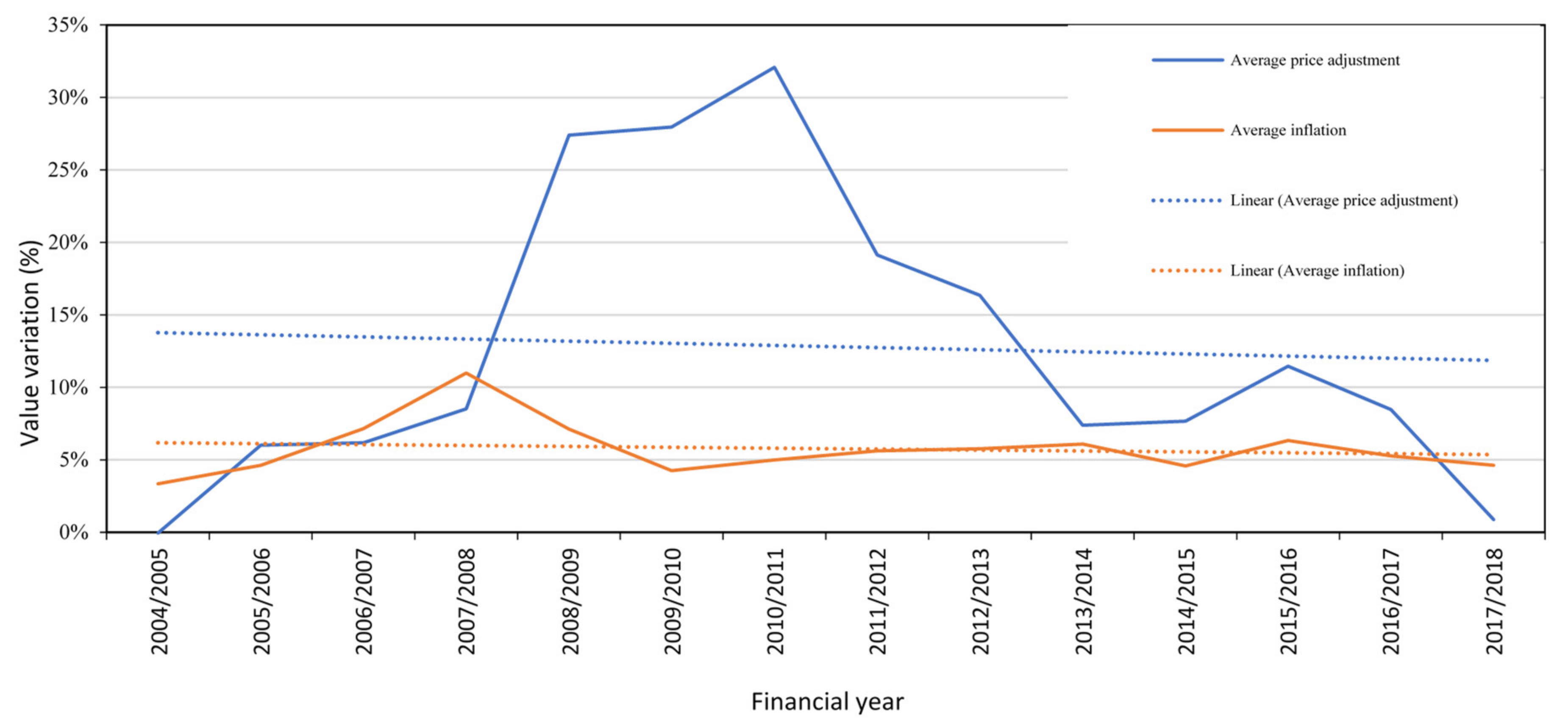
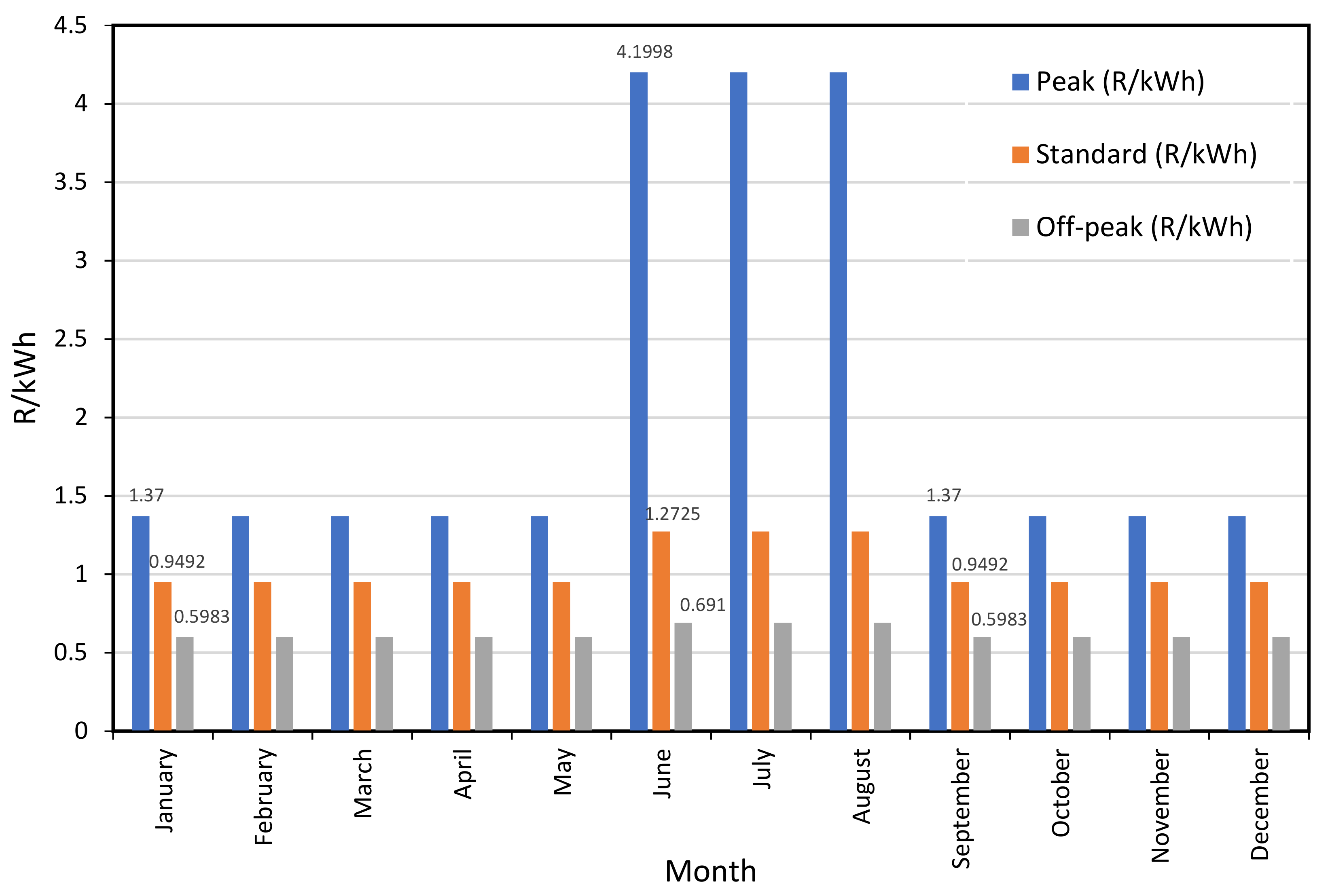
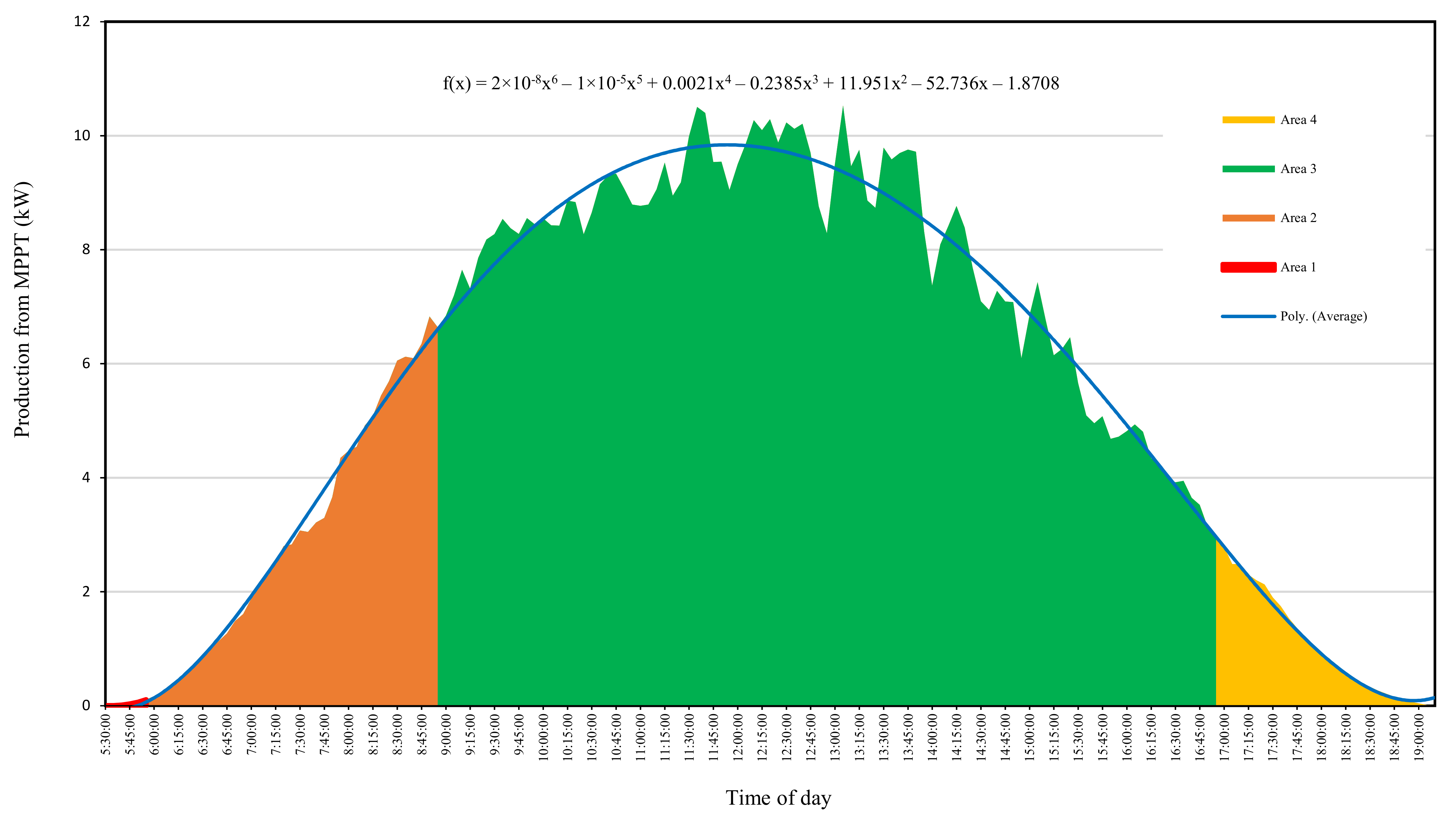
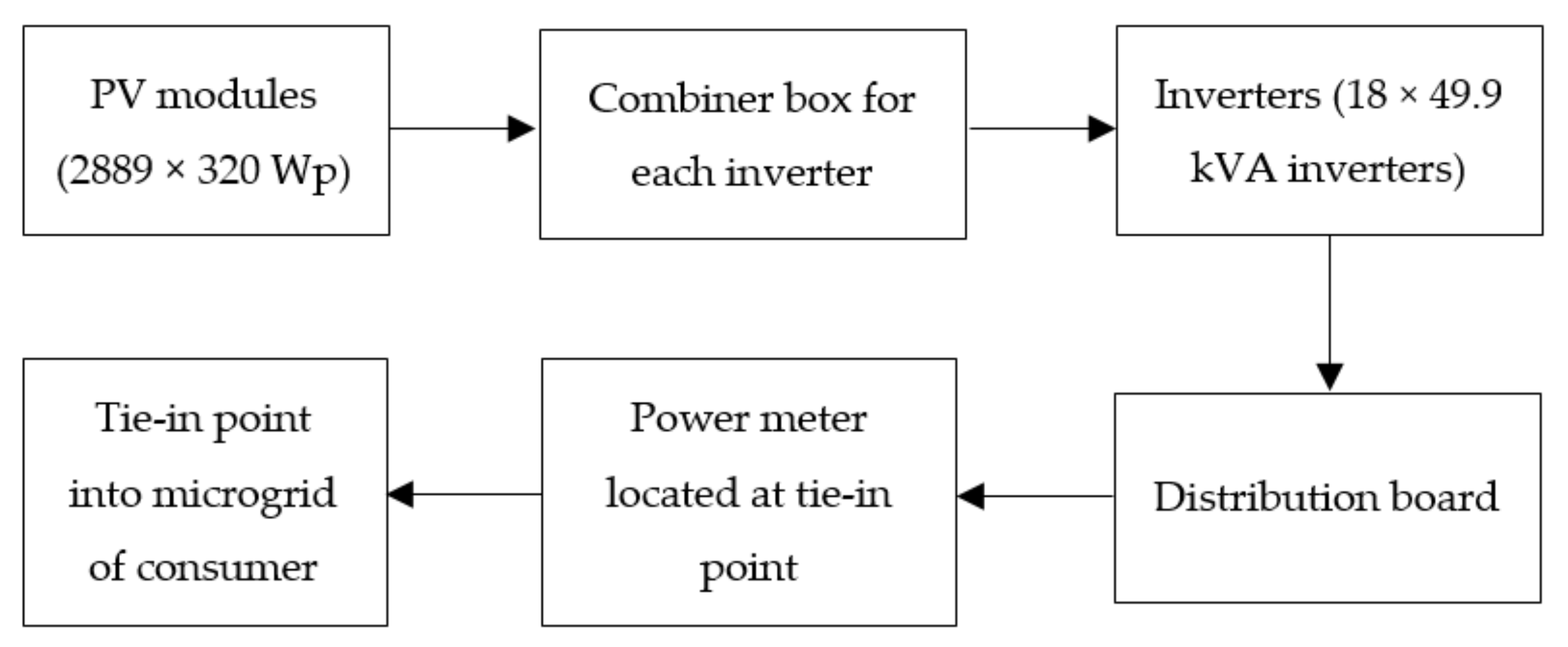

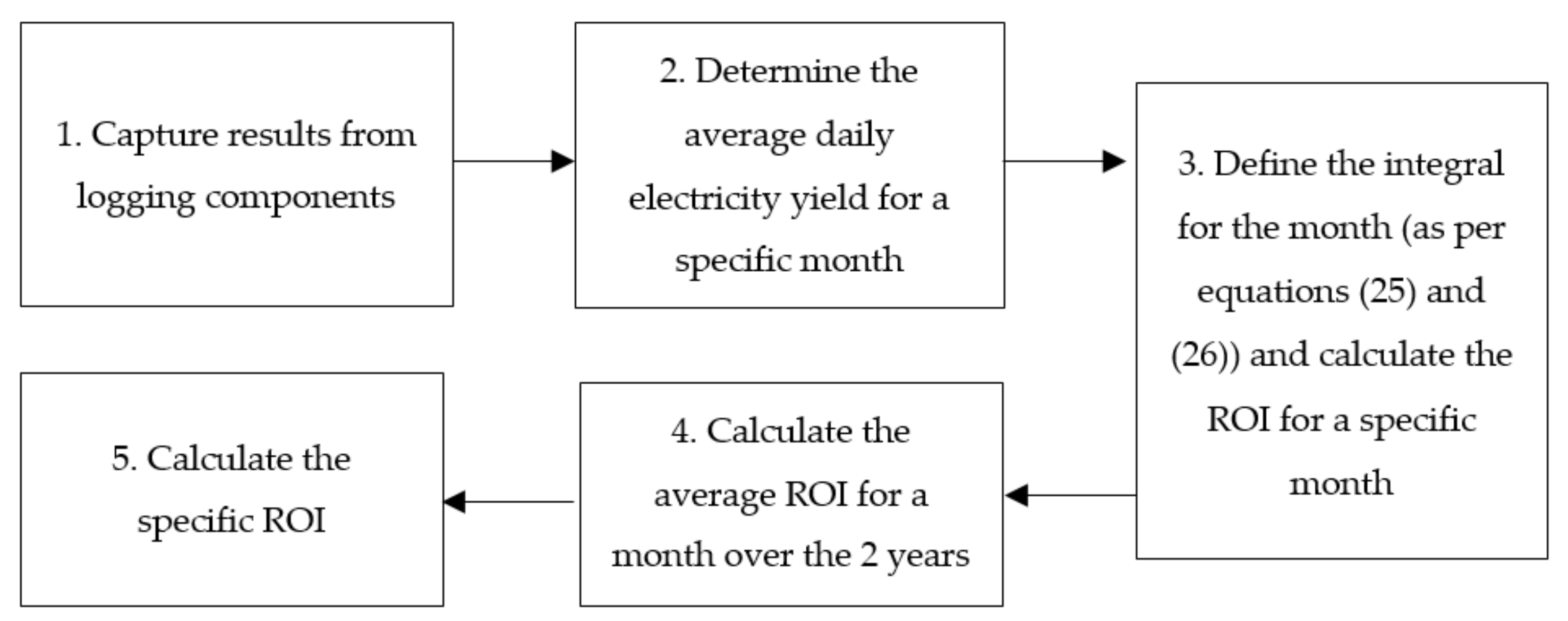
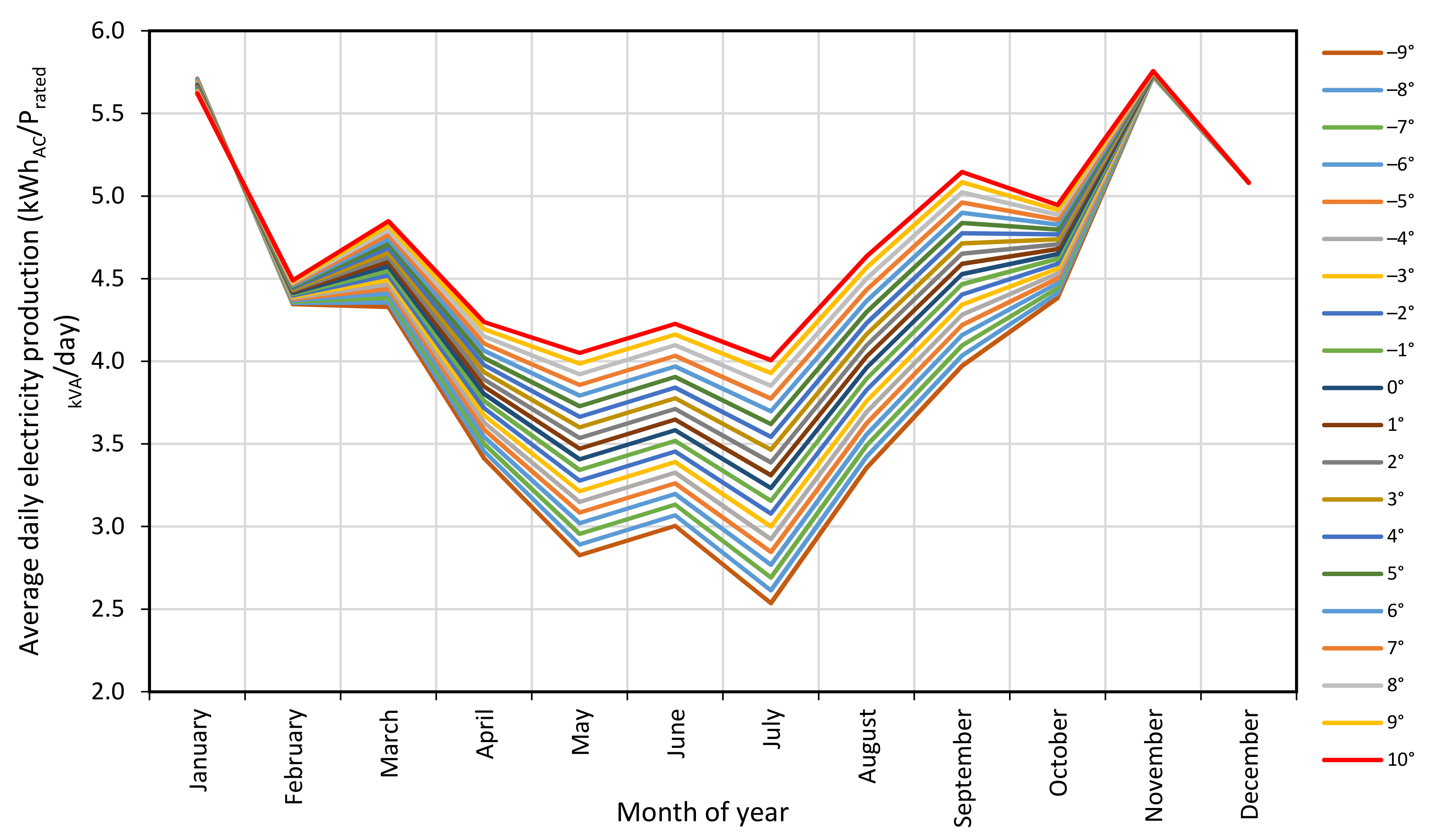
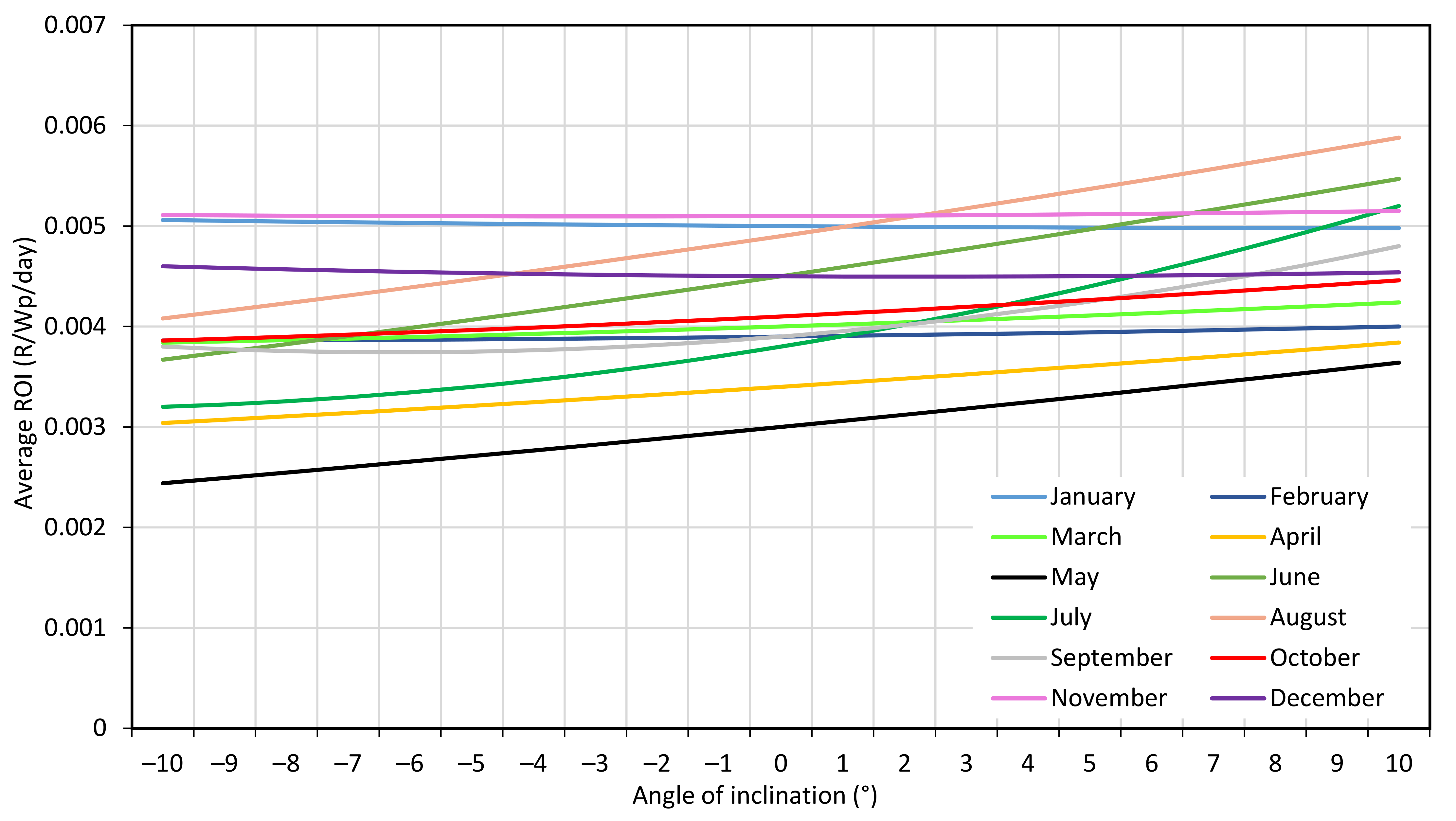
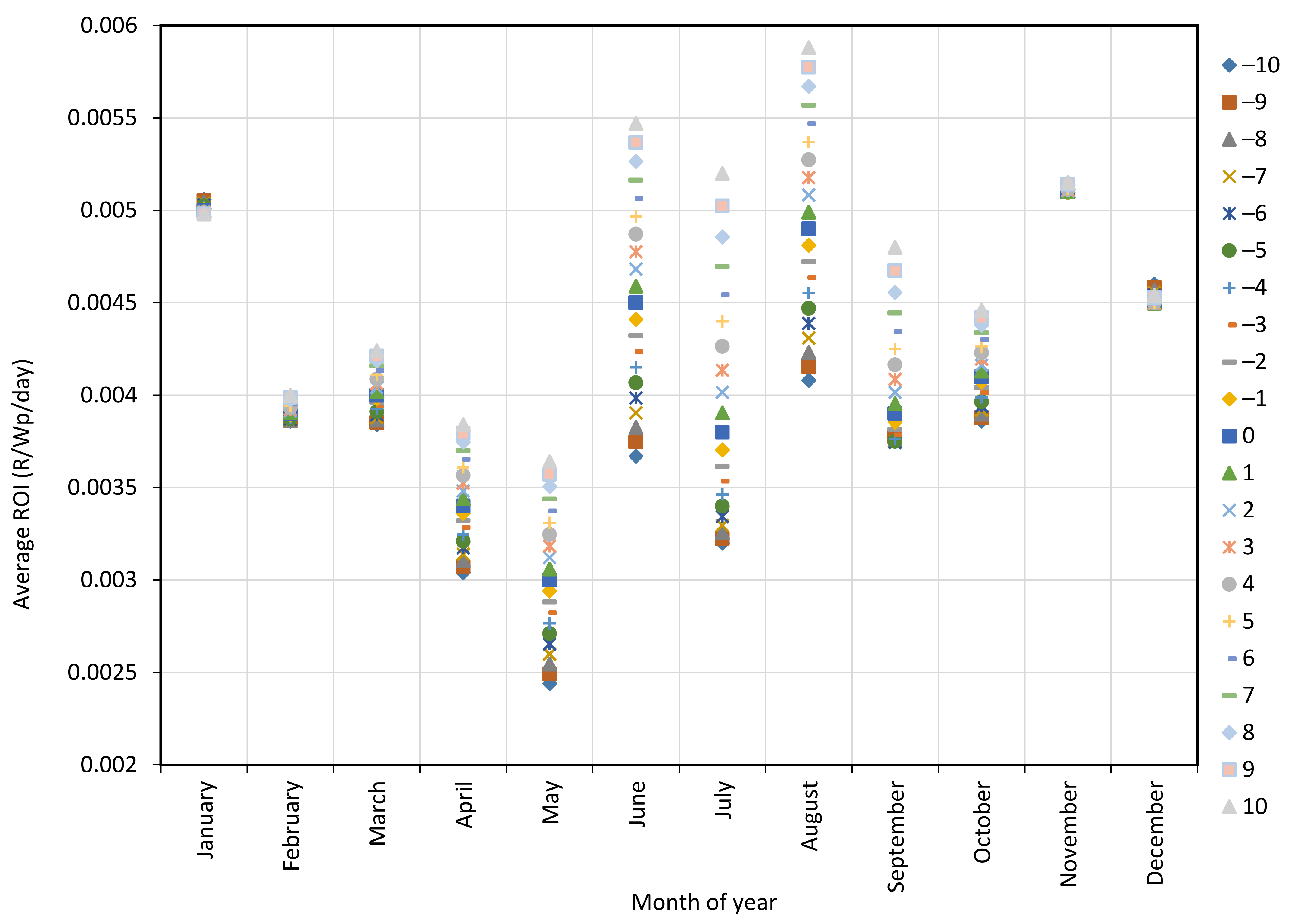
| Type of Analysis | Location of Study | System Size | Description of Analysis | Reference |
|---|---|---|---|---|
| Generation of an economic performance model | China | N/A | A cost-benefit model was derived to study the economic performance of a PV system under current policies | [28] |
| Analyses of case studies | Spain | 1.2 to 2.6 kWp at a fixed angle | A model was derived that allows the user to maximise the energy consumed from the PV systems to optimise the cost-competitiveness of PV systems. | [29] |
| Generation of a cost-benefit mathematical model | China | N/A | An analysis was conducted on concentrated solar power (CSP) systems to improve policies and investment decisions | [30] |
| Analyses of case studies | Iran | Approximately 5 kW at a fixed angle | An evaluation of various PV systems was conducted to determine the economic performance of the PV systems, including the LCOE, NPV, ROI, Payback period | [31] |
| Analyses of case studies | Forli, Italy | All less than 3 kWp at a fixed angle | Analyses were conducted on various PV systems to determine the pay-back period. | [32] |
| Nomenclature | |||
|---|---|---|---|
| Ratio of O & M costs to payable input tax | Feed-in tariff | ||
| The proportion of VAT refunds | Self-use electricity price | ||
| The ratio of self-use electricity | Subsidy price | ||
| PV system comprehensive influence coefficient (generally 75% [28]) | The present value of cash inflow | ||
| Degradation rate of the PV system | The present value of fuel costs | ||
| Radiation coefficient of PV modules (generally 1.1 [28]) | The present value of annual insurance costs | ||
| Discount rate | The present value of interest on loans | ||
| Insurance costs | The present value of capital expenditure | ||
| O & M costs | The present value of O & M costs | ||
| Interest | The present value of construction costs | ||
| Initial cash flow | The present value of VAT tax expenditure | ||
| Annual cash inflow | The net present value of investment cost | ||
| Annual cash outflow | The power generated from the system in a period | ||
| Depreciation period | Repayment period | ||
| Annual generation | Income tax rate | ||
| Inflation rate per period | Lifecycle of system | ||
| Standard solar radiation intensity | Additional tax rate (surtax) | ||
| Annual radiation accepted by the region | VAT tax rate | ||
| In the year | Income tax | ||
| Loans ratio in total investment | Sales tax | ||
| Loan interest rate | Total expenditure | ||
| Number of periods (year) | Total revenues | ||
| Installed capacity of the system | Value-added tax | ||
| Overnight construction costs | |||
| Description | Cost Weight/Value | Unit |
|---|---|---|
| Parameter: Initial Investment Costs | ||
| PV panel capacity | 50–55% of aggregate cost of system | R |
| Inverter | 8–10% of aggregate cost of system | R |
| Logging software | 0–1% of aggregate cost of system | R |
| Fixation components of PV panels | 10–15% of aggregate cost of system | R |
| Cabling and general | 6–10% of aggregate cost of system | R |
| Environmental impact assessment | 0–1% of aggregate cost of system, if required | R |
| Site cleaning | 0–5% of aggregate cost of system, if required | R |
| Transportation | 0–5% of aggregate cost of system | R |
| Installation cost | 5–10% of aggregate cost of system | R |
| Parameter: Future Operating Costs | ||
| Operation and maintenance (O & M) cost | 0–3% of the PV system cost | R |
| O & M cost growth rate (nominal) | 0.49% | % |
| O & M cost growth rate (real) | 6–10% | % |
| Failure rate of PV panels and inverters | 0–5% of rated PV system size | % |
| Labour cost to repair | 0–1% of O & M cost/annum | R/year |
| Growth rate of labour cost (nominal) | 1% | % |
| Degradation rate of PV modules | 20% of rated PV panel capacity over 25 years | %/year |
| Inflation rate | 4–5%/annum | %/year |
| Parameter: Financing Parameters | ||
| Current retail electricity price | Varies as per tariff structure | R/kWh |
| Current tariff increase rate | 7–8 | %/year |
| Loan amount | 80 | % (based on the author’s assumption) |
| Load interest rate | 10.25 | % |
| Financing period | 10–15 | years |
| Salvage value rate | 15% | 15% |
| Demand Classification (Season) | Electricity Classification | Weekday | Saturday | Sunday |
| High demand (June–August) | Peak hours | 06:00–09:00; 17:00–19:00 | N/A | N/A |
| Low demand (August–May) | 07:00–10:00; 18:00–20:00 | N/A | N/A | |
| High demand | Standard hours | 09:00–17:00; 19:00–22:00 | 07:00–12:00; 18:00–20:00 | N/A |
| Low demand | 06:00–07:00; 10:00–18:00; 20:00–22:00 | 07:00–12:00; 18:00–20:00 | N/A | |
| High demand | Off-peak hours | 22:00–06:00 | 20:00–07:00; 12:00–18:00 | 00:00–24:00 |
| Low demand | 22:00–06:00 | 20:00–07:00; 12:00–18:00 | 00:00–24:00 |
| Parameter: System Design Characteristics | ||
|---|---|---|
| Component Description | Name and Model/Quantity | Unit |
| Inverter | Kaco new energy Powador 60.0 TL3 | |
| Number of inverters | 18 | |
| Rated inverter power | 49.9 | kVA |
| PV module | Canadian Solar Inc. CS6X-320P | |
| Number of PV modules | 2 889 | W |
| Rated PV module power (1 module) | 320 | W |
| Latitude (within a 40 km radius of the case study) | 26°8′12.02″ S | |
| Longitude (within a 40 km radius of the case study) | 28°14′28.13″ E | |
| Plane tilt | –9 ≤ ≤ 10 | ° |
| Azimuth | 0 | ° |
| PV module fixation method | Rooftop, approximately 200 mm from the surface of the roof | |
| DC cable length | 50–200 (6 mm2 DC cable) | m |
| Approximate DC voltage loss at max load | 0.36—0.84 | % |
| AC cable length | 75 (4 × 95 mm2 × 4 core SWA ECC armoured cables) | m |
| Approximate AC voltage loss at max load | 1.3275 | % |
| System logging component | Solar-log 2000 | |
| Parameter: System Operating Conditions | ||
| Installation date of system components | 1 August 2016—30 November 2016 | |
| System commission date | 1 December 2016 | |
| Start date of analysis | December 2016 (Month 1) | |
| Stop date of analysis | November 2018 (Month 24) | |
Publisher’s Note: MDPI stays neutral with regard to jurisdictional claims in published maps and institutional affiliations. |
© 2021 by the authors. Licensee MDPI, Basel, Switzerland. This article is an open access article distributed under the terms and conditions of the Creative Commons Attribution (CC BY) license (http://creativecommons.org/licenses/by/4.0/).
Share and Cite
van Vuuren, D.J.; Marnewick, A.L.; Pretorius, J.H.C. A Financial Evaluation of a Multiple Inclination, Rooftop-Mounted, Photovoltaic System Where Structured Tariffs Apply: A Case Study of a South African Shopping Centre. Energies 2021, 14, 1666. https://doi.org/10.3390/en14061666
van Vuuren DJ, Marnewick AL, Pretorius JHC. A Financial Evaluation of a Multiple Inclination, Rooftop-Mounted, Photovoltaic System Where Structured Tariffs Apply: A Case Study of a South African Shopping Centre. Energies. 2021; 14(6):1666. https://doi.org/10.3390/en14061666
Chicago/Turabian Stylevan Vuuren, Dirk Johan, Annlizé L. Marnewick, and Jan Harm C. Pretorius. 2021. "A Financial Evaluation of a Multiple Inclination, Rooftop-Mounted, Photovoltaic System Where Structured Tariffs Apply: A Case Study of a South African Shopping Centre" Energies 14, no. 6: 1666. https://doi.org/10.3390/en14061666







